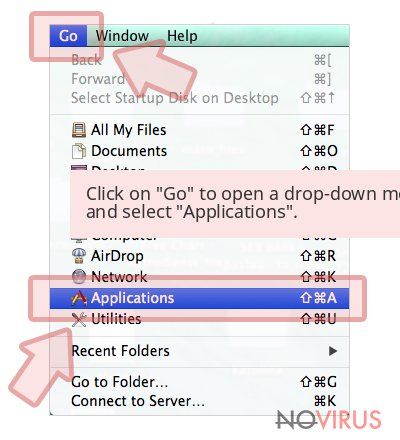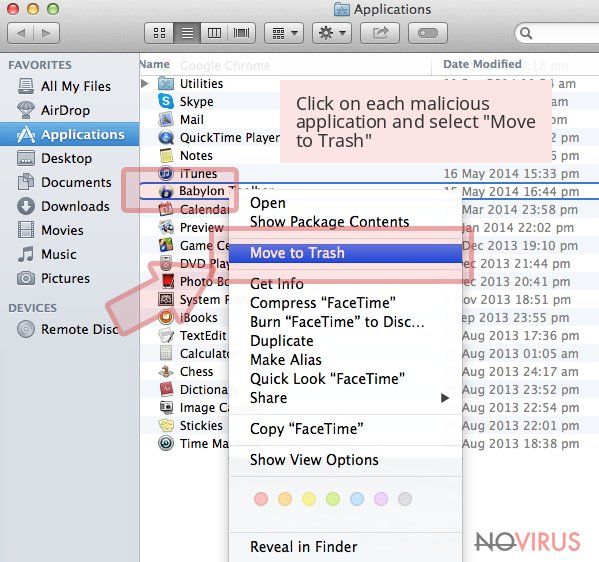Remove My Safe Savings (Uninstall Guide) - Oct 2018 updated
My Safe Savings Removal Guide
Description of My Safe Savings
My Safe Savings virus is a potentially unwanted program that frustrates users with constant redirects

My Safe Savings virus may trick you that it is a useful application that helps save some money during online shopping. If you have been looking for tools that deliver various shopping offers or discount coupons, this program may have caught your eyes. However, we strongly recommend keeping away from this application.
It’s nothing more than an adware program which delivers an excessive amount of fake and misleading commercial content. My Safe Savings ads usually promote suspicious software or warn about the necessity to update particular programs. Remember that all safe and reliable updates or installers are offered only on developers’ websites.
Ads like these may include malware or redirect to dangerous sites that are created for spreading viruses. Suspicious pop-ups, banners, in-text and other ads follow users to each Internet site they are visiting. These ads may be placed instead of real ones or hide important content.
Besides, if you decide to find X button, you may fail in doing it, or you may be still redirected to the third-party website. What should you do then? The answer is simple, remove My Safe Savings from the computer. Quickly install FortectIntego and run a full system scan.
You can suspect that adware sneaked inside the PC when your computer becomes sluggish, and browser frequently freezes. Of course, the main sign of the infection is an increased amount of ads that are often labelled as ‘Powered by My Safe Savings,' ‘Ads by My Safe Savings’ or similarly.
Even though they deliver a great offer to shop on Amazon or other discount coupons, you should resist clicking them. As we already mentioned, one of the biggest threats is My Safe Savings redirect issues. After one click you may end up on malicious site or install dangerous computer infection.
Keep in mind that these ads may be interesting or offers relevant. It happens because adware program monitors your browsing activity and collects browsing-related information in order to deliver interest-based ads. Users tend to click only on relevant content, and every click generates some money from the developers. If you do not want to be a money making tool and risk your computer’s safety, you should hurry up with My Safe Savings removal.

How does it spread?
Adware program which is responsible for delivering My Safe Savings ads spread bundled with freeware and shareware. The developers use deceptive software marketing method called ‘bundling’ which allows adding and hiding their application in another software package. Usually, users have no clue that they might install not a single program but the package full of useless and unwanted applications.
It happens because users always choose quick or recommended installation setup. However, if you want to avoid My Safe Savings hijack or protect your PC from other unwanted programs in the future, you have to choose custom or advanced settings that allow monitoring and adjusting software installation process. But you have to pay proper attention to each step. When you see the list of pre-selected programs, deselect them all and continue without worries and some suspicious app may interfere browsing the Internet with intrusive ads.
How to eliminate My Safe Savings adware?
Even though you love online shopping and still want to save some money, this application won’t help you to do it. So, stay away from it or if it found the way to your PC, uninstall it immediately. For My Safe Savings removal, you have two options – manual and automatic elimination.
The first methods may be complicated, so it’s more suitable for advanced computer users. The second technique is suitable for everyone who wants to get rid of computer infection quickly and without putting lots of effort. Therefore, you have to make a decision which method seems better for you. If you decide to choose manual removal, you should know that our team has prepared instructions how to remove My Safe Savings manually, which you can find below.
You may remove virus damage with a help of FortectIntego. SpyHunter 5Combo Cleaner and Malwarebytes are recommended to detect potentially unwanted programs and viruses with all their files and registry entries that are related to them.
Getting rid of My Safe Savings. Follow these steps
Uninstall My Safe Savings in Windows systems
Follow the instructions carefully and remove My Safe Savings with all its related components. Then, check all your web browsers, remove suspicious extensions and reset their settings.
Terminate suspicious programs from Windows 10/8 machines by following these instructions:
- Type Control Panel into Windows search and once the result shows up hit Enter.
- Under Programs, choose Uninstall a program.
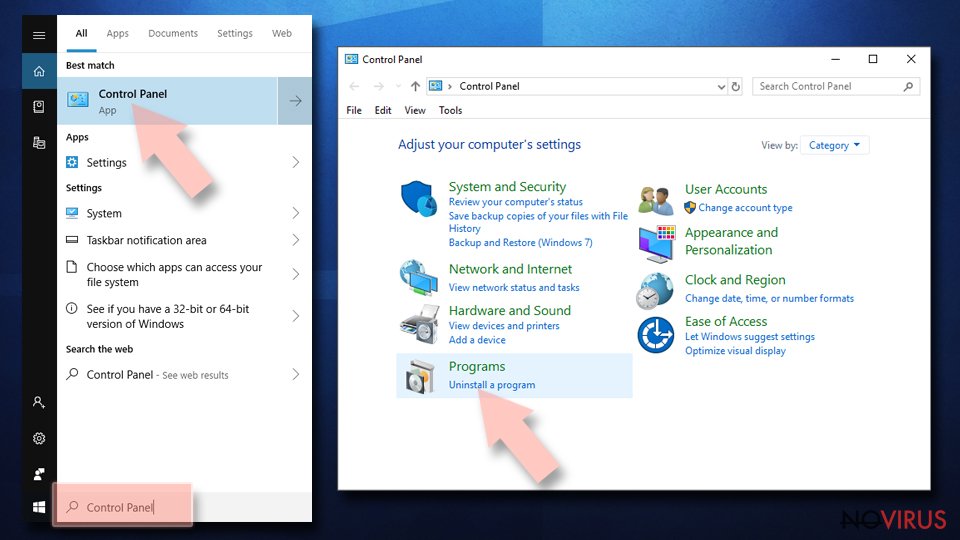
- Find components related to suspicious programs.
- Right-click on the application and select Uninstall.
- Click Yes when User Account Control shows up.

- Wait for the process of uninstallation to be done and click OK.
Windows 7/XP instructions:
- Click on Windows Start and go to Control Panel on the right pane.
- Choose Add/Remove Programs.
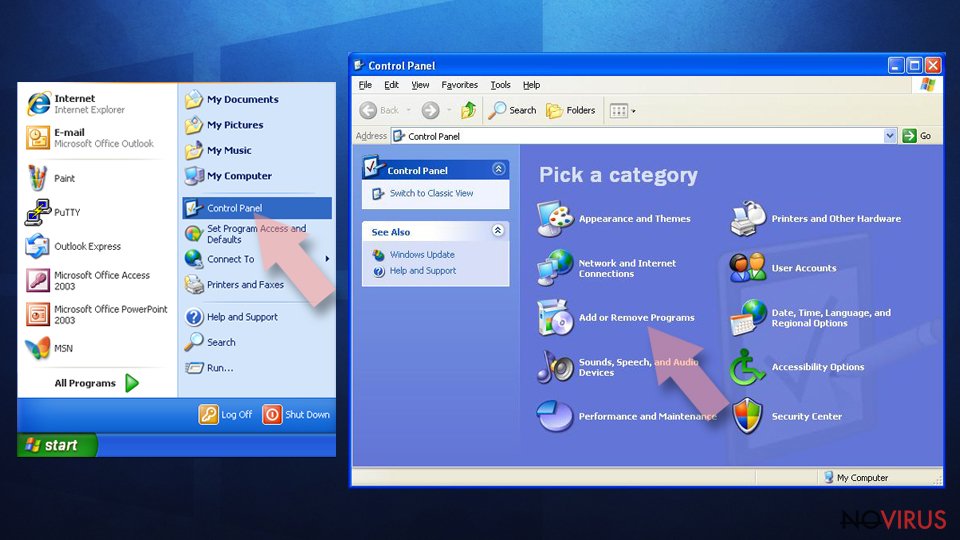
- Select Uninstall a program under Programs in Control Panel.
- Click once on the unwanted application.
- Click Uninstall/Change at the top.
- Confirm with Yes.
- Click OK and finish the removal.
Uninstall My Safe Savings in Mac OS X system
-
Users who use OS X should click on Go button, which can be found at the top left corner of the screen and select Applications.

-
Wait until you see Applications folder and look for My Safe Savings or any other suspicious programs on it. Now right click on every of such entries and select Move to Trash.

Delete My Safe Savings from Microsoft Edge
Delete suspicious extensions from MS Edge:
- Go to the Menu by clicking on the three horizontal dots at the top-right.
- Then pick Extensions.
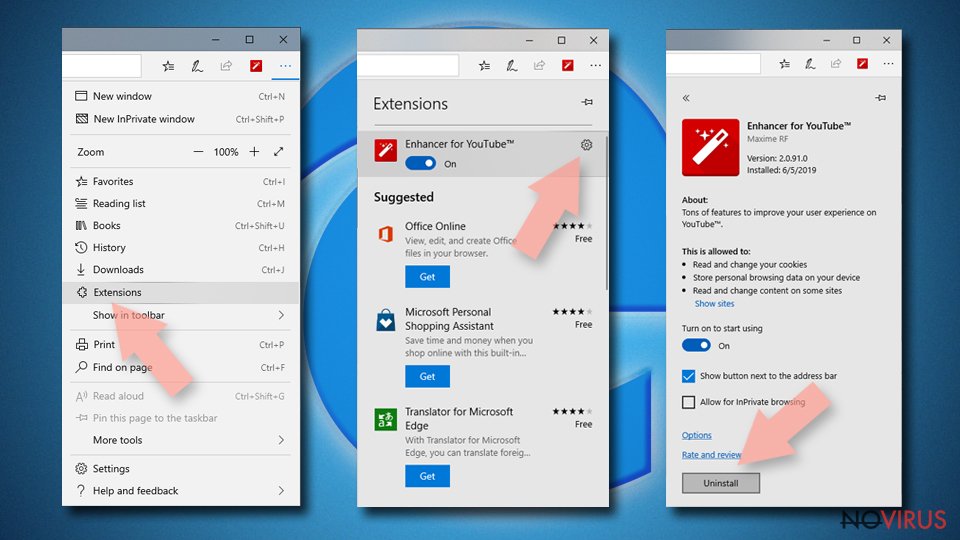
- Choose the unwanted add-ons on the list and click on the Gear icon.
- Click on Uninstall at the bottom.
Clear cookies and other data:
- Click on the Menu and from the context menu select Privacy & security.
- Under Clear browsing data, select Choose what to clear.
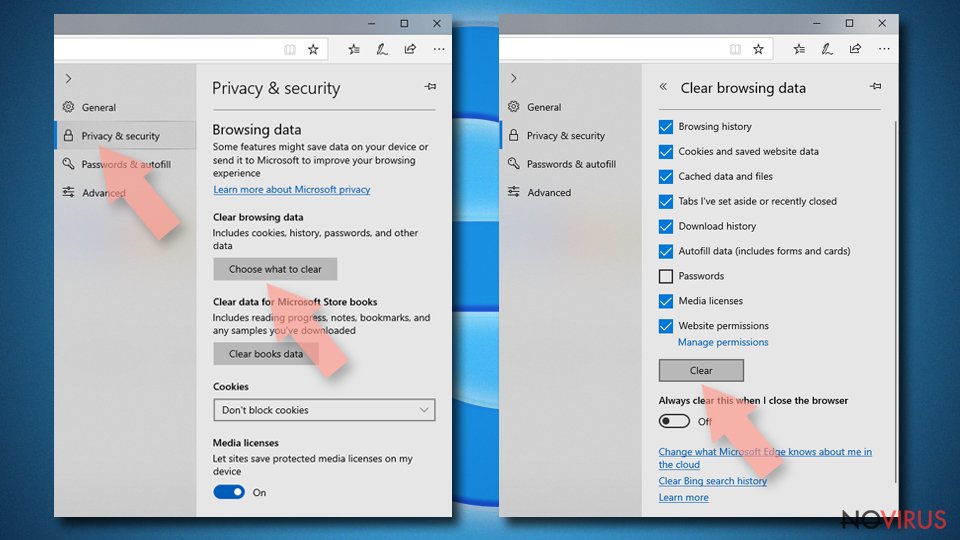
- Choose everything except passwords, and click on Clear.
Alter new tab and homepage settings:
- Click the menu icon and choose Settings.
- Then find On startup section.
- Click Disable if you found any suspicious domain.
Reset MS Edge fully:
- Click on the keyboard Ctrl + Shift + Esc to open Task Manager.
- Choose More details arrow at the bottom.
- Go to Details tab.
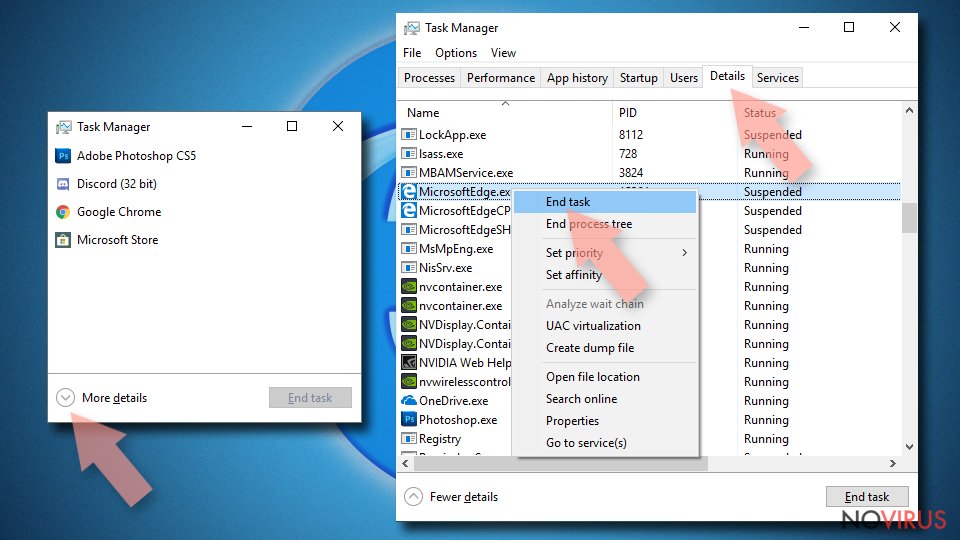
- Now scroll down and locate every entry with Microsoft Edge name in it.
- Right-click on each of them and select End Task to stop MS Edge from running.
When none of the above solves the issue, you might need an advanced Edge reset method, but you need to backup your data before proceeding.
- Find the following folder on the PC: C:\\Users\\%username%\\AppData\\Local\\Packages\\Microsoft.MicrosoftEdge_8wekyb3d8bbwe.
- Press Ctrl + A on your keyboard to select all folders.
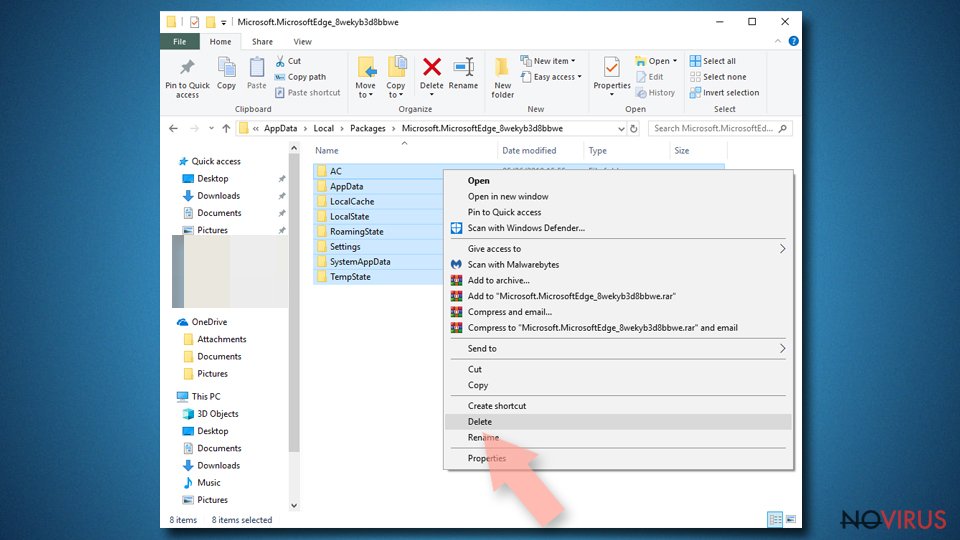
- Right-click on the selection and choose Delete
- Right-click on the Start button and pick Windows PowerShell (Admin).
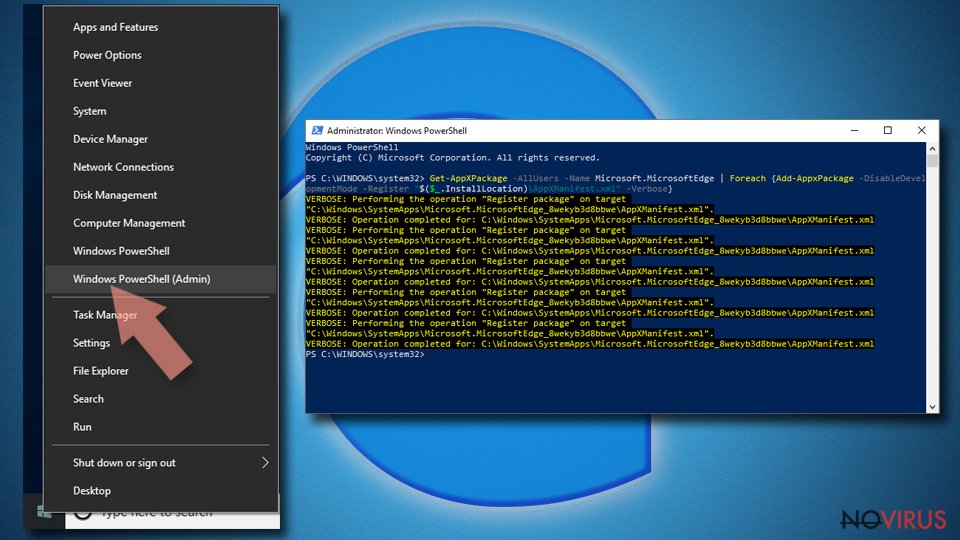
- Copy and paste the following command, and then press Enter:
Get-AppXPackage -AllUsers -Name Microsoft.MicrosoftEdge | Foreach {Add-AppxPackage -DisableDevelopmentMode -Register “$($_.InstallLocation)\\AppXManifest.xml” -Verbose
Instructions for Chromium-based Edge
Delete extensions:
- Open Edge and click Settings.
- Then find Extensions.
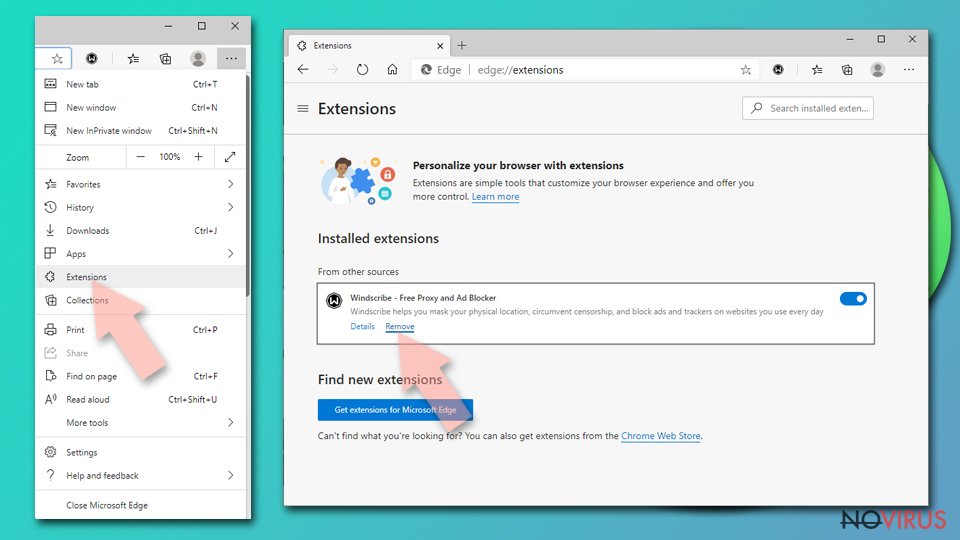
- Delete unwanted extensions with the Remove.
Clear cache and site data:
- Click on Menu and then Settings.
- Find Privacy and services.
- Locate Clear browsing data, then click Choose what to clear.
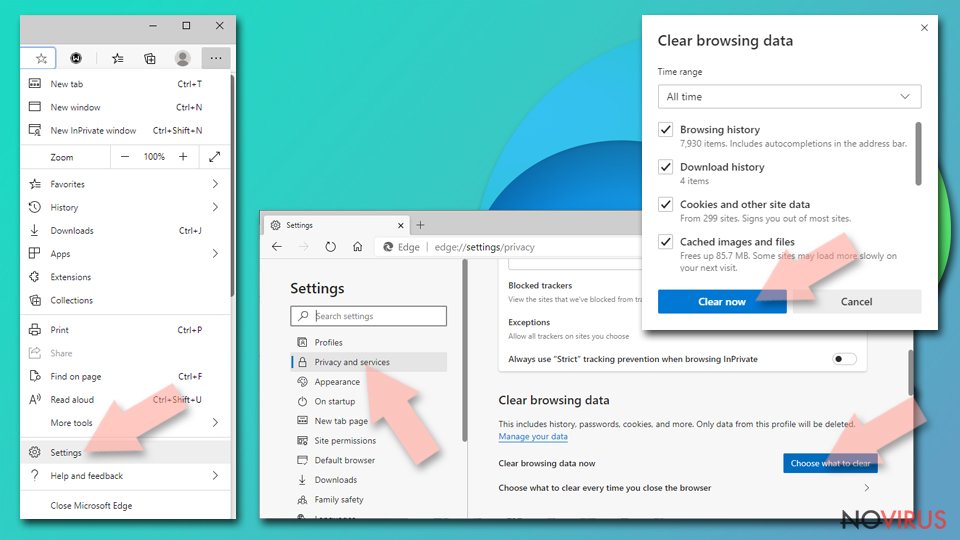
- Time range.
- Click All time.
- Select Clear now.
Reset Chromium-based MS Edge browser fully:
- Go to Settings.
- On the left side, choose Reset settings.

- Select Restore settings to their default values.
- Click Reset.
Delete My Safe Savings from Mozilla Firefox (FF)
Follow the instructions and remove all suspicious browser extensions from Mozilla Firefox.
Remove suspicious Firefox extensions:
- Open Mozilla Firefox browser and click on the three horizontal lines at the top-right to open the menu.
- Select Add-ons in the context menu.
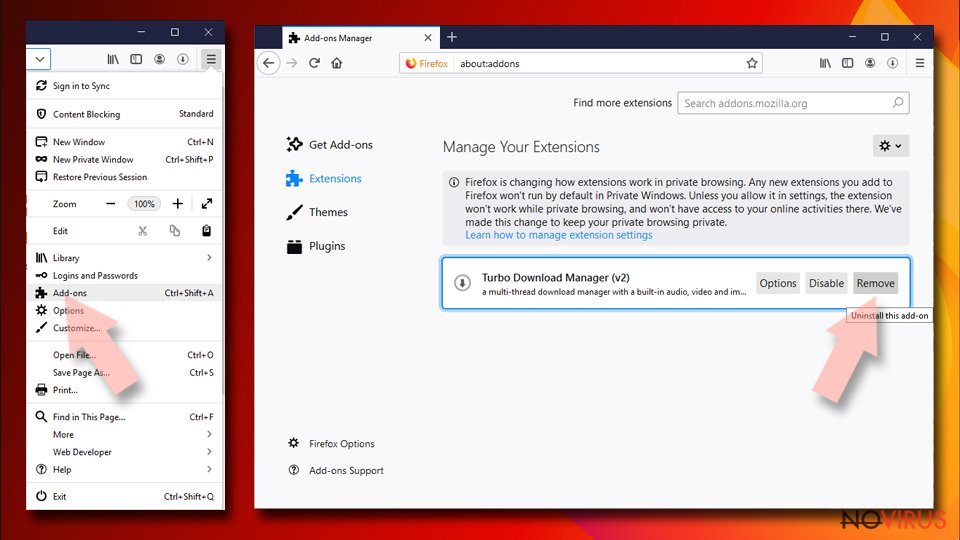
- Choose plugins that are creating issues and select Remove.
Reset the homepage on the browser:
- Click three horizontal lines at the top right corner.
- This time select Options.
- Under Home section, enter your preferred site for the homepage that will open every time you launch Mozilla Firefox.
Clear cookies and site data:
- Click Menu and pick Options.
- Find the Privacy & Security section.
- Scroll down to choose Cookies and Site Data.
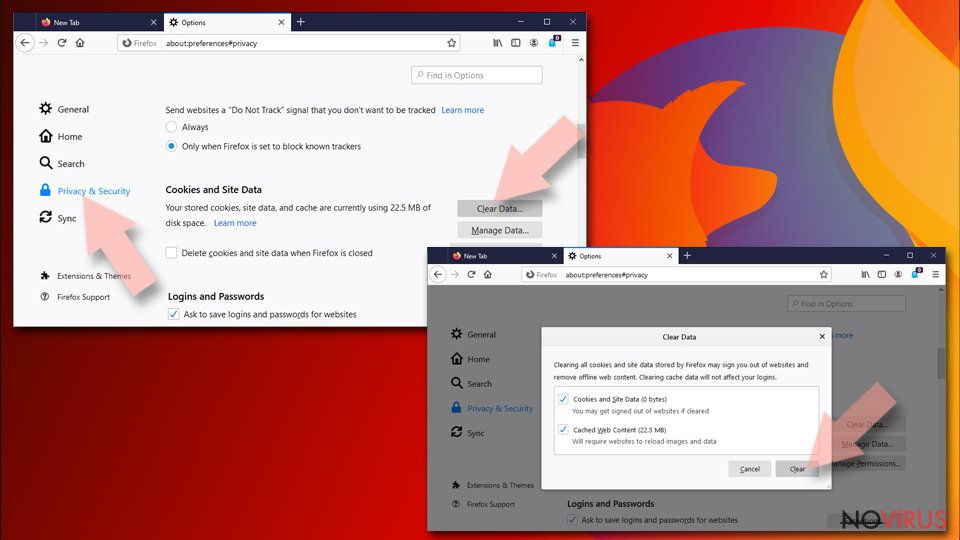
- Click on Clear Data… option.
- Click Cookies and Site Data, Cached Web Content and press Clear.
Reset Mozilla Firefox:
If none of the steps above helped you, reset Mozilla Firefox as follows:
- Open Mozilla Firefox and go to the menu.
- Click Help and then choose Troubleshooting Information.
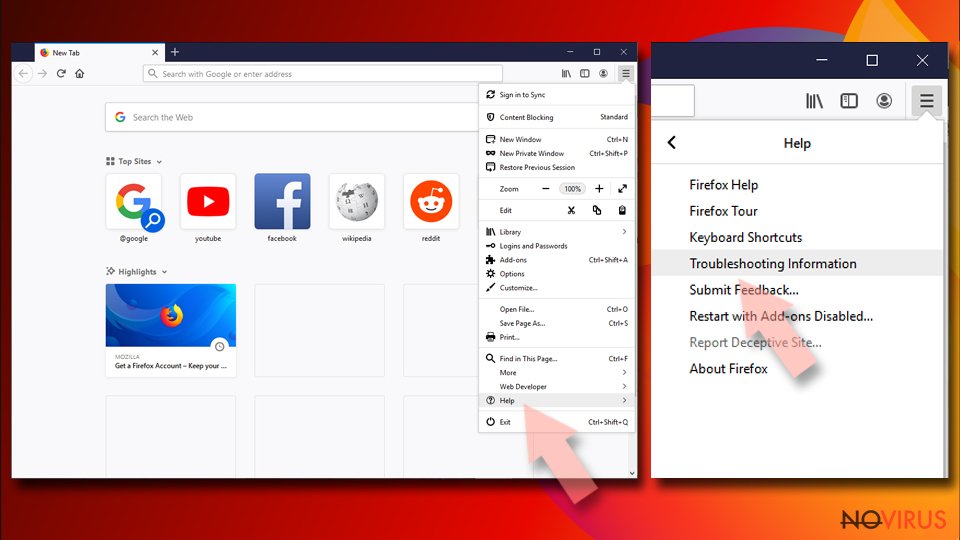
- Locate Give Firefox a tune-up section, click on Refresh Firefox…
- Confirm the action by pressing on Refresh Firefox on the pop-up.
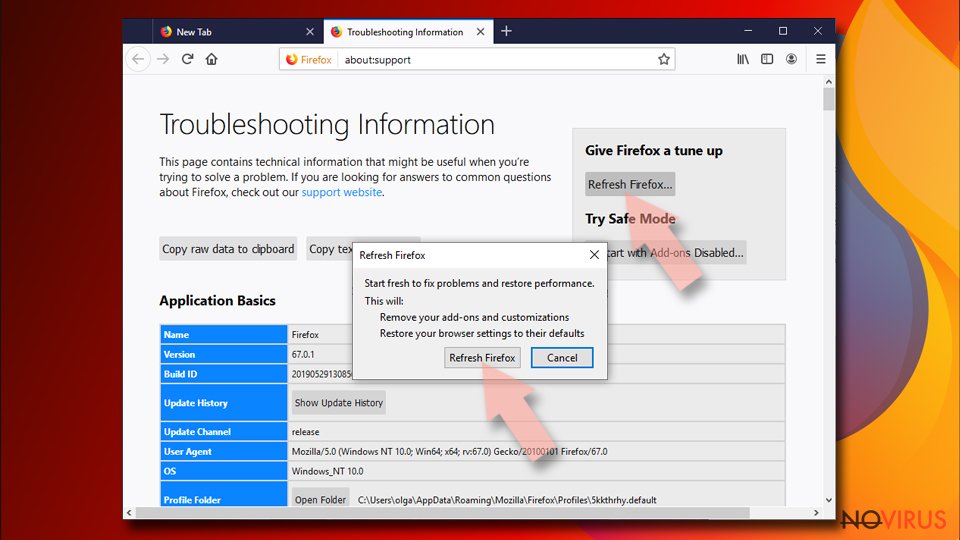
Chrome browser reset
Look through the list of extensions and if you find some questionable extensions that have been recently installed to Google Chrome, remove them immediately.
Find and remove suspicious extensions from Google Chrome:
- In Google Chrome, open the Menu by clicking three vertical dots at the top-right corner.
- Select More tools > Extensions.
- Once the window opens, you will see all the installed extensions.
- Find any suspicious add-ons related to any PUP.
- Uninstall them by clicking Remove.
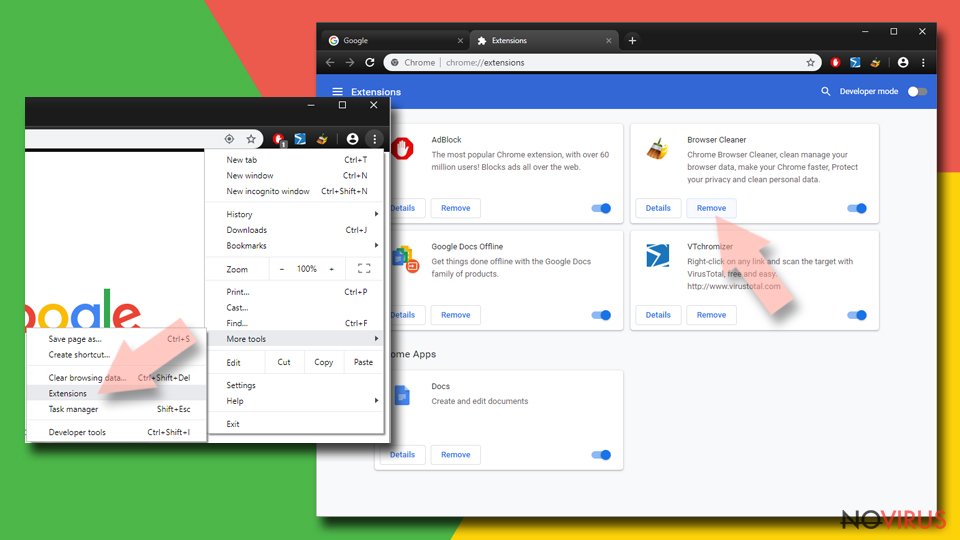
Clear cache and web data from Chrome:
- Click the Menu and select Settings.
- Find Privacy and security section.
- Choose Clear browsing data.
- Select Browsing history.
- Cookies and other site data, also Cached images and files.
- Click Clear data.
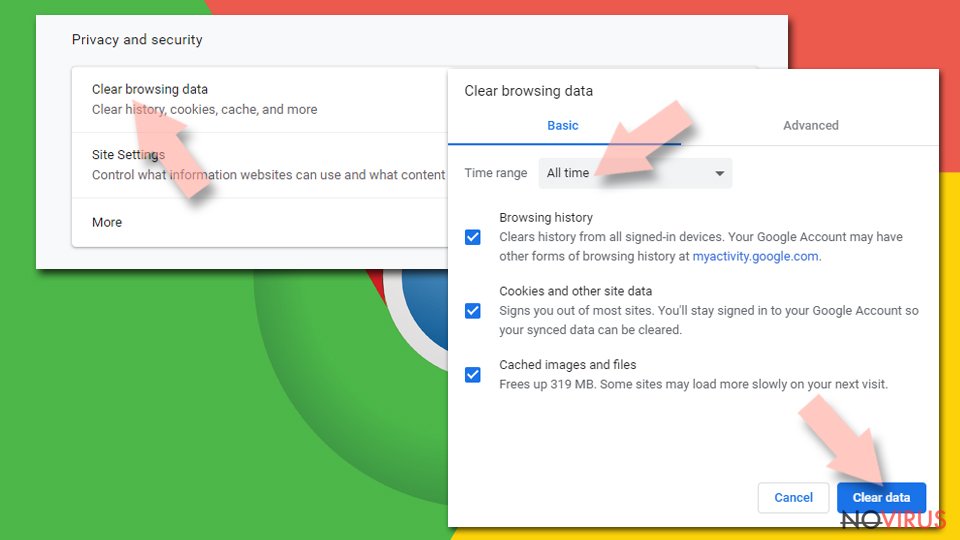
Alter settings of the homepage:
- Go to the menu and choose Settings.
- Find odd entries in the On startup section.
- Click on Open a specific or set of pages.
- Then click on three dots and look for the Remove option.
Reset Google Chrome fully:
You might need to reset Google Chrome and properly eliminate all the unwanted components:
- Go to Chrome Settings.
- Once there, scroll down to expand Advanced section.
- Scroll down to choose Reset and clean up.
- Click Restore settings to their original defaults.
- Click Reset settings again.
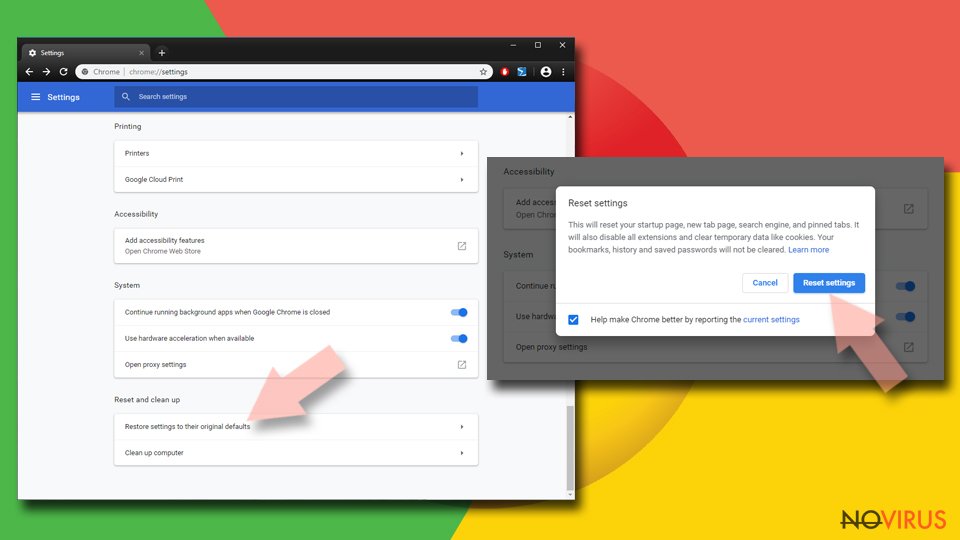
Delete My Safe Savings from Safari
Get rid of questionable extensions from Safari:
- Click Safari.
- Then go to Preferences…
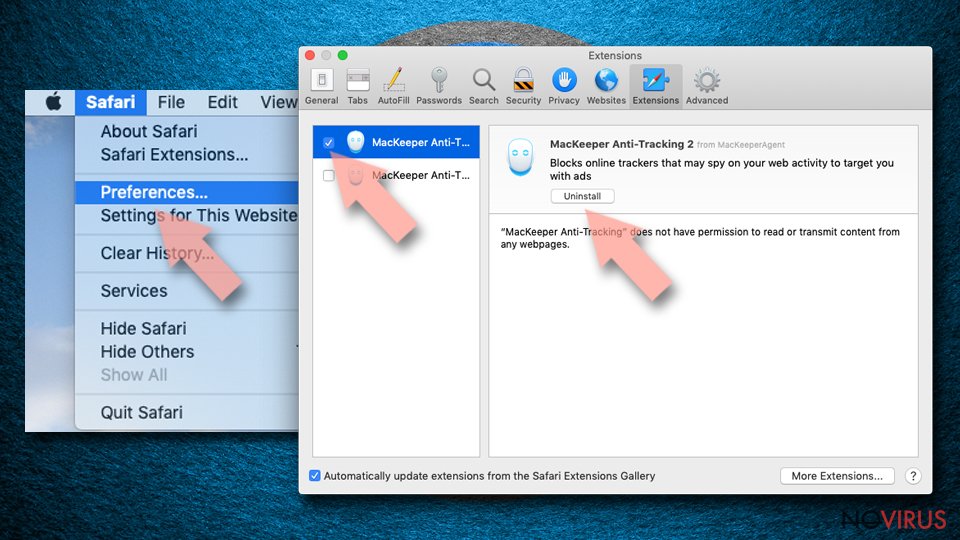
- Choose Extensions on the menu.
- Select the unwanted extension and then pick Uninstall.
Clear cookies from Safari:
- Click Safari.
- Choose Clear History…
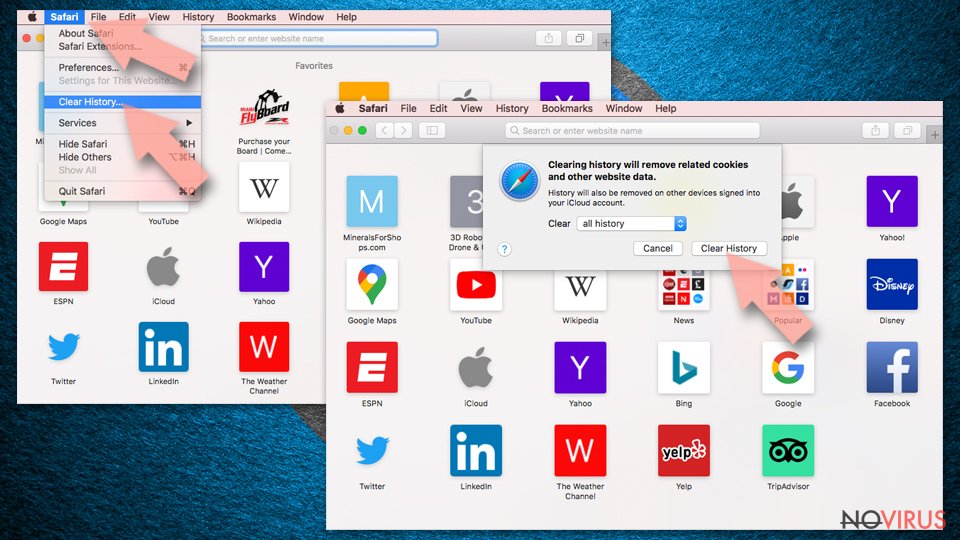
- From the drop-down menu under Clear, find and pick all history.
- Confirm with Clear History.
Reset Safari fully:
- Click Safari and then Preferences…
- Choose the Advanced tab.
- Tick the Show Develop menu in the menu bar.
- From the menu bar, click Develop.
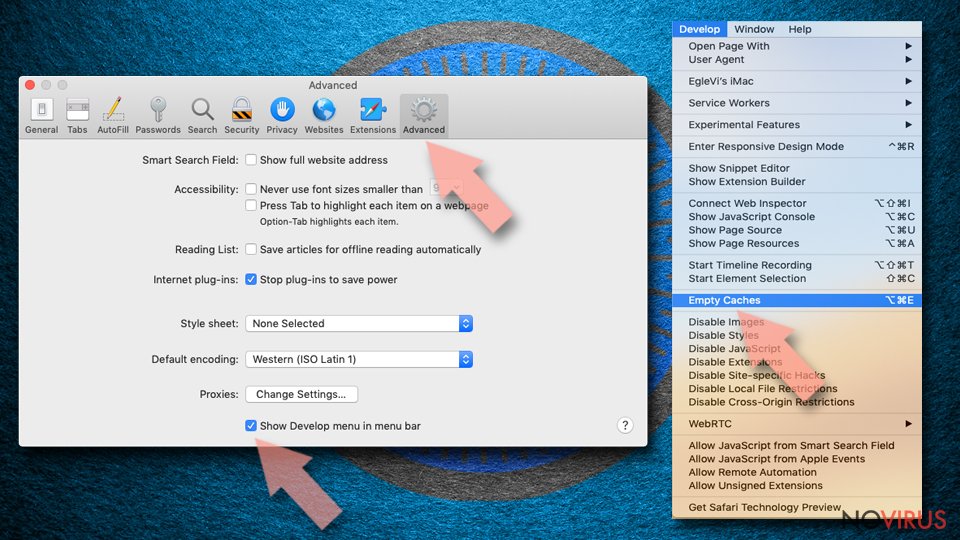
- Then select Empty Caches.
Even if you have completed all the steps above, we still strongly recommend you to scan your computer system with a powerful anti-malware software. It is advisable to do that because an automatic malware removal tool can detect and delete all remains of My Safe Savings, for instance, its registry keys. The anti-malware program can help you to easily detect and eliminate possibly dangerous software and malicious viruses in an easy way. You can use any of our top-rated malware removal programs: FortectIntego, SpyHunter 5Combo Cleaner or Malwarebytes.
How to prevent from getting adware
Securely connect to your website wherever you are
Sometimes you may need to log in to a content management system or server more often, especially if you are actively working on a blog, website, or different project that needs constant maintenance or that requires frequent content updates or other changes. Avoiding this problem can be easy if you choose a dedicated/fixed IP address. It's a static IP address that only belongs to a specific device and does not change when you are in different locations.
VPN service providers such as Private Internet Access can help you with these settings. This tool can help you control your online reputation and successfully manage your projects wherever you are. It is important to prevent different IP addresses from connecting to your website. With a dedicated/fixed IP address, VPN service, and secure access to a content management system, your project will remain secure.
Recover files damaged by a dangerous malware attack
Despite the fact that there are various circumstances that can cause data to be lost on a system, including accidental deletion, the most common reason people lose photos, documents, videos, and other important data is the infection of malware.
Some malicious programs can delete files and prevent the software from running smoothly. However, there is a greater threat from the dangerous viruses that can encrypt documents, system files, and images. Ransomware-type viruses focus on encrypting data and restricting users’ access to files, so you can permanently lose personal data when you download such a virus to your computer.
The ability to unlock encrypted files is very limited, but some programs have a data recovery feature. In some cases, the Data Recovery Pro program can help recover at least some of the data that has been locked by a virus or other cyber infection.
